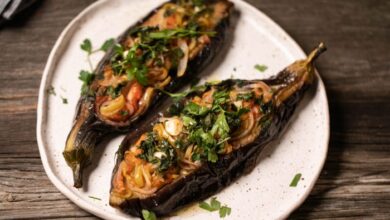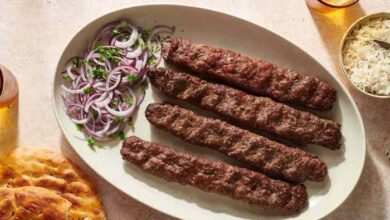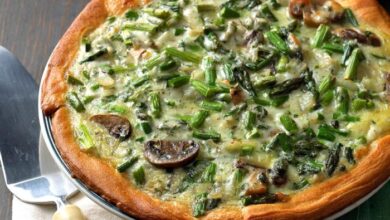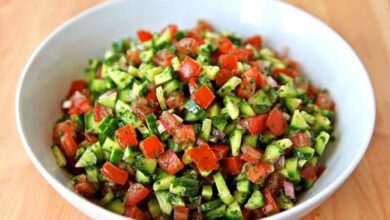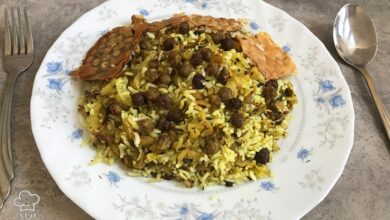
Persian New Year Recipes: A Culinary Journey Through Tradition
Persian New Year Recipes are a celebration of tradition, family, and the promise of a fresh start. Nowruz, the Persian New Year, is a time for renewal and joy, and food plays a central role in these festivities.
From the symbolic significance of each dish to the regional variations that reflect the rich cultural tapestry of Persia, these recipes offer a glimpse into the heart of Persian culture. Whether you’re a seasoned cook or a curious novice, there’s something here to inspire you to create a truly memorable Nowruz feast.
The History and Significance of Nowruz
Nowruz, meaning “new day” in Persian, is a vibrant and ancient festival celebrated by millions across the globe, particularly in the Middle East, Central Asia, and parts of the Balkans. This joyous occasion marks the beginning of spring and the renewal of life, symbolizing hope, rebirth, and the triumph of light over darkness.
Origins and Historical Significance of Nowruz
The origins of Nowruz can be traced back to ancient Persia, specifically to the Achaemenid Empire (550-330 BCE). During this period, the Persian calendar was based on a solar year, and the vernal equinox, marking the beginning of spring, was a significant event.
The celebration of Nowruz became an official event during the reign of Cyrus the Great, who is credited with establishing the Persian Empire. Nowruz was celebrated as a time of peace, prosperity, and renewal, reflecting the values of the Achaemenid Empire.
Cultural and Religious Significance of Nowruz
Nowruz holds immense cultural and religious significance in Persian culture. The festival is deeply rooted in Zoroastrianism, the ancient Persian religion, which emphasizes the importance of light, purity, and renewal. Nowruz is also celebrated by many Muslims in Iran and other parts of the world, although it is not considered a religious holiday in Islam.
The festival serves as a bridge between different faiths and cultures, fostering unity and shared traditions.
Traditional Customs and Rituals of Nowruz
Nowruz celebrations are filled with vibrant traditions and rituals that have been passed down through generations.
Persian New Year, or Nowruz, is a time for fresh starts and delicious feasts. While traditional dishes like reshte (noodle) soup and sabzi polo (herb rice) are always on the menu, I love adding a touch of the unexpected.
This year, I’m serving up a vibrant and flavorful linguini with roasted broccoli pesto alongside the classics. The bright green pesto, bursting with the taste of roasted broccoli, is a perfect complement to the rich flavors of Nowruz.
- House Cleaning:Before the arrival of Nowruz, families engage in a thorough cleaning of their homes, symbolizing a fresh start and the removal of negativity. This practice is known as “Khane Tekani,” which literally means “shaking the house.”
- Haft-Sin:The Haft-Sin is a centerpiece of the Nowruz celebration, consisting of seven items, each starting with the letter “S” in Persian, representing different aspects of life. These items are:
- Sabzeh (Sprouts):Symbolizing rebirth and growth.
- Samanu (Sweet Pudding):Representing prosperity and abundance.
- Senjed (Dried Oleaster Berries):Representing love and fertility.
- Seeb (Apple):Symbolizing health and beauty.
- Serkeh (Vinegar):Representing patience and resilience.
- Sir (Garlic):Symbolizing protection against evil.
- Somāq (Sumac):Representing sunrise and the beginning of a new year.
- Eidi:The tradition of giving “Eidi”
- gifts of money or sweets
- to children and younger family members is a cherished custom of Nowruz. This symbolizes blessings and good luck for the new year.
Essential Persian New Year Dishes
Nowruz is a time for family, friends, and feasting, and the table is laden with a variety of traditional dishes that symbolize prosperity, health, and happiness for the coming year. These dishes are not just delicious but also hold deep cultural and symbolic significance, making them an integral part of the Nowruz celebration.
The Symbolic Meanings of Nowruz Dishes
Each dish served during Nowruz carries a special meaning, reflecting the hopes and aspirations of the Persian people for the new year. The vibrant colors and flavors of these dishes represent the beauty and bounty of nature, while their preparation and sharing symbolize the importance of family, community, and togetherness.
- Sabzi Polo (Herbed Rice): This fragrant rice dish is a staple of Nowruz celebrations, symbolizing life, growth, and renewal. The fresh herbs, such as parsley, cilantro, and chives, represent the vibrant green of spring and the promise of a fruitful year.
- Kuku Sabzi (Herb Omelet): This flavorful omelet, packed with fresh herbs, symbolizes the earth’s bounty and the hope for a prosperous year. The vibrant green color of the kuku sabzi also represents the arrival of spring.
- Samanu (Wheat Pudding): This sweet and creamy pudding, made from germinated wheat, symbolizes prosperity and abundance. It is believed to bring good fortune and wealth to the household.
- Reshteh Polo (Noodle Rice): This dish, featuring long, thin noodles, symbolizes longevity and a long life. The noodles are believed to represent the threads of life, and their length signifies a long and healthy life.
- Sorkh (Red): The color red, often represented by pomegranate seeds or sumac, symbolizes joy, happiness, and good luck. It is believed to ward off evil spirits and bring good fortune.
- Fish (Mahi): Fish, particularly those swimming upstream, symbolize progress, success, and overcoming challenges. They are often served as a reminder to strive for greater heights in the new year.
The Historical Context and Origins of Nowruz Dishes
Many of the traditional Nowruz dishes have deep historical roots, reflecting the rich culinary heritage of Persia. These dishes have evolved over centuries, adapting to local ingredients and traditions.
- Sabzi Polo: This dish is believed to have originated in ancient Persia, where herbs were highly valued for their medicinal and culinary properties. The use of herbs in Sabzi Polo reflects the Persian tradition of using fresh, natural ingredients.
- Kuku Sabzi: This dish is thought to have originated in the Middle Ages, when eggs were a valuable source of protein. The addition of herbs to the omelet not only enhances its flavor but also adds nutritional value.
- Samanu: This pudding is believed to have been a staple of the Persian diet for centuries. The use of germinated wheat in Samanu reflects the Persian tradition of using grains for nourishment and medicinal purposes.
- Reshteh Polo: This dish is thought to have originated in the Safavid era, when noodles were introduced to Persia from China. The long, thin noodles of Reshteh Polo symbolize longevity and a long life, reflecting the Persian belief in the importance of family and community.
Recipes for Traditional Persian New Year Dishes
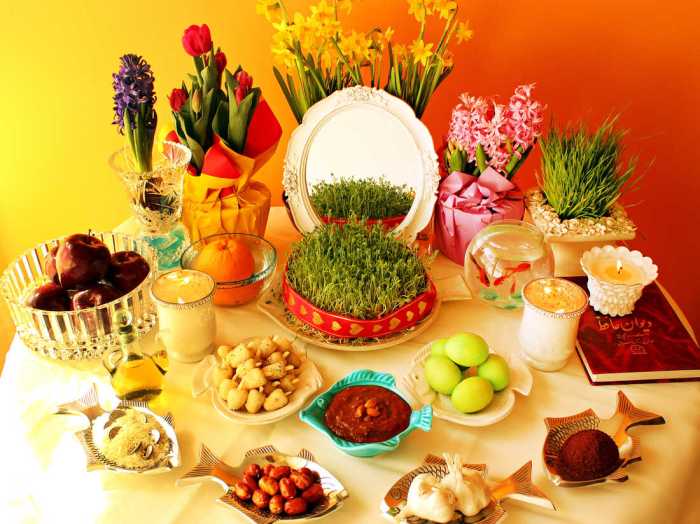
Nowruz, the Persian New Year, is a time for celebration, family, and feasting. A traditional Nowruz table, known as a Haft Seen, is set with seven items starting with the letter “S” in Farsi, symbolizing prosperity and good fortune for the coming year.
These dishes are not only delicious but also hold deep cultural significance.
Traditional Persian New Year Dishes
Here are some popular Nowruz dishes that you can try making at home:
| Dish Name | Ingredients | Preparation | Description |
|---|---|---|---|
| Sabzi Polo (Herb Rice) |
|
|
A fragrant and colorful rice dish that is a staple of Nowruz celebrations. The herbs symbolize freshness and new beginnings. |
| Kuku Sabzi (Herb Frittata) |
|
|
A savory frittata made with a variety of herbs, representing the vibrancy of spring. |
| Reshteh Polo (Noodle Rice) |
|
|
A hearty and flavorful rice dish with noodles and chickpeas, symbolizing longevity and prosperity. |
| Ash Reshteh (Noodle Soup) |
|
|
A comforting and nourishing soup made with noodles, chickpeas, and spinach, representing health and well-being. |
Regional Variations in Persian New Year Cuisine
Nowruz, the Persian New Year, is a celebration of renewal and rebirth, and its culinary traditions are as diverse as the regions of Iran and the diaspora. From the Caspian Sea coast to the Zagros Mountains, each region boasts its own unique dishes and variations on classic recipes, reflecting local ingredients, cultural influences, and historical practices.
Regional Variations in Persian New Year Dishes
The diversity of Nowruz cuisine is a testament to the rich cultural heritage of Iran. Here are some examples of regional variations in dishes:
Northern Iran
- Ash-e Reshteh:This hearty lentil and noodle soup is a staple in northern Iran, particularly in the provinces of Gilan and Mazandaran. It is believed to have originated in the Caspian Sea region, where rice and wheat were readily available.
- Kuku Sabzi:This savory herb frittata is another popular dish in northern Iran, often made with a variety of fresh herbs, including parsley, dill, chives, and spinach. The use of herbs reflects the region’s abundant green landscapes.
- Shirini Berengi:This sweet rice pudding is a favorite dessert in northern Iran, particularly in the city of Rasht. The dish is often flavored with saffron, rose water, and almonds, adding a touch of sweetness and elegance to the celebration.
Southern Iran
- Qormeh Sabzi:This flavorful stew is a signature dish of southern Iran, particularly in the provinces of Fars and Khuzestan. It is made with lamb, kidney beans, and a variety of herbs, including parsley, cilantro, and chives.
- Kuku Sabzi:This dish, while common in northern Iran, has a slightly different preparation method in southern Iran. It often includes ground meat and spices, giving it a more savory flavor profile.
- Faloodeh:This refreshing noodle dessert is a popular treat in southern Iran, particularly in the city of Shiraz. It is made with thin vermicelli noodles, rose water, and lime juice, providing a cool and tangy contrast to the richness of other Nowruz dishes.
Persian New Year, or Nowruz, is a time for family, celebration, and of course, delicious food! While traditional dishes like Sabzi Polo and Reshteh Polo are always on the menu, I’m always looking for new ways to add a twist.
This year, I’m thinking of serving a flavorful pressure cooker barbeque chicken, like the one found here , as a side dish. It’s quick, easy, and the smoky flavor would complement the bright and fresh flavors of the Persian dishes perfectly.
Central Iran
- Zereshk Polo:This saffron rice dish is a favorite in central Iran, particularly in the provinces of Isfahan and Yazd. It is made with barberries, a tart berry that adds a unique flavor and color to the rice.
- Kuku Sabzi:In central Iran, Kuku Sabzi often incorporates ingredients like walnuts and dried fruits, adding a touch of richness and sweetness to the dish.
- Baghlava:This flaky pastry is a popular dessert in central Iran, particularly in the city of Isfahan. It is made with layers of filo dough, filled with chopped nuts and sweetened with honey or sugar syrup.
Persian Diaspora
- Nowruz Cuisine in the United States:The Persian diaspora in the United States has adapted traditional Nowruz dishes to incorporate local ingredients and flavors. For example, some families may use American-style spinach instead of Persian herbs in their Kuku Sabzi, or they may add cheese or sour cream to their Ash-e Reshteh.
- Nowruz Cuisine in Europe:The Persian diaspora in Europe has also embraced local ingredients and flavors in their Nowruz cuisine. For instance, some families may use European-style rice or lentils in their dishes, or they may add spices or herbs that are commonly used in European cuisine.
Modern Interpretations of Persian New Year Recipes
The traditional dishes of Nowruz, passed down through generations, are undergoing a fascinating transformation in the modern era. Chefs and home cooks are reinterpreting these classic recipes, infusing them with contemporary techniques and ingredients while staying true to the essence of Persian flavors.
This evolution is a testament to the adaptability and vibrancy of Persian cuisine, reflecting the impact of globalization and cultural exchange.
Modern Techniques and Ingredients
Modern interpretations of Persian New Year dishes often incorporate innovative techniques and ingredients, adding a contemporary twist to traditional recipes. These adaptations showcase the creativity and adaptability of Persian cuisine, while preserving the essence of its flavors.
- Molecular Gastronomy:Chefs are experimenting with techniques like spherification and emulsification to create unique textures and presentations. For example, a traditional reshte(vermicelli noodle) dish might feature spherified pomegranate seeds, adding a playful and modern touch.
- Fusion Cuisine:The blending of Persian flavors with other cuisines, like Japanese or Italian, results in exciting and unexpected combinations. Imagine a sabzi polo(herb rice) dish infused with the umami richness of Japanese dashi, or a kuku sabzi(herb frittata) incorporating the fresh acidity of Italian lemon zest.
- Sustainable Practices:With a growing awareness of sustainability, chefs are using seasonal and locally sourced ingredients to create modern interpretations of traditional dishes. This approach not only supports local farmers but also enhances the freshness and authenticity of the flavors.
Examples of Innovative Recipes
Here are some examples of innovative recipes that demonstrate the modern interpretations of Persian New Year dishes:
- Modernized Kuku Sabzi: A traditional kuku sabzi(herb frittata) can be elevated with the addition of a creamy goat cheese filling and a sprinkle of toasted pistachios. This modern take on the classic dish offers a richer texture and a more nuanced flavor profile.
Persian New Year, or Nowruz, is all about fresh starts and vibrant flavors. While traditional dishes like sabzi polo and reshteh polo are staples, I always love to add a modern twist with a colorful and healthy salad. This year, I’m planning to make a colorful kale and spinach salad with a homemade dressing to complement the richness of the main courses.
It’s the perfect way to balance the flavors and celebrate the new year with a burst of freshness.
- Deconstructed Reshte: Instead of the traditional long vermicelli noodles, a deconstructed reshtedish might feature a bed of saffron-infused rice topped with individual strands of reshte, pan-seared scallops, and a drizzle of pomegranate molasses. This modern approach presents a playful and elegant interpretation of the classic dish.
- Molecular Samanu: Samanu, a traditional sweet pudding made from wheat germ, can be transformed using molecular gastronomy techniques. A spherified samanudessert might feature a core of creamy samanuencased in a delicate, translucent sphere. This innovative presentation adds a touch of modern elegance to the traditional sweet.
Tips for Hosting a Persian New Year Feast
Hosting a Persian New Year feast, known as Haft-Sin, is a wonderful way to celebrate Nowruz with family and friends. It’s a time for joy, reflection, and sharing delicious traditional dishes. Here are some tips to make your feast a memorable one:
Creating a Festive Atmosphere
Creating a festive atmosphere is crucial for a memorable Nowruz celebration. The Haft-Sin table, the centerpiece of the feast, should be adorned with symbolic items representing the seven S’s:
- Sabzeh(wheatgrass): symbolizes rebirth and renewal.
- Seeb(apple): represents beauty and health.
- Senjed(jujube fruit): symbolizes love and prosperity.
- Serkeh(vinegar): represents patience and longevity.
- Samanu(wheat pudding): represents abundance and prosperity.
- Sonbol(hyacinth): symbolizes spring and new beginnings.
- Sirk(garlic): represents protection and warding off evil spirits.
In addition to the Haft-Sin, you can enhance the festive atmosphere by incorporating traditional Persian decorations such as colorful tablecloths, embroidered napkins, and decorative plates.
Setting the Table for a Memorable Celebration
Setting the table for a Persian New Year feast is an art form. The table should be adorned with vibrant colors and traditional elements. Here are some tips for setting a memorable table:
- Choose a colorful tablecloth:Red, green, and gold are traditional colors for Nowruz celebrations. You can also opt for a tablecloth with intricate Persian designs.
- Use traditional Persian plates and bowls:If you have them, use traditional Persian plates and bowls to add an authentic touch to the table. If not, choose dishes in vibrant colors that complement the tablecloth.
- Include embroidered napkins:Embroidered napkins add a touch of elegance and tradition to the table.
- Place the Haft-Sin table in a prominent location:The Haft-Sin table should be the centerpiece of the feast and should be placed in a prominent location in the room.
- Include candles and flowers:Candles and flowers add a touch of warmth and beauty to the table.
Serving and Enjoying Persian New Year Dishes
Serving and enjoying Persian New Year dishes is an integral part of the celebration. It’s important to be aware of some traditions and etiquette associated with these dishes:
- Serving order:It’s customary to start with appetizers, such as nuts, dried fruits, and cheese, followed by main courses, such as reshte (vermicelli noodles), sabzi polo (herb rice), and kuku sabzi (herb frittata).
- Sharing dishes:Persian New Year dishes are often shared, with each person taking a small portion from a communal plate.
- Using bread as a utensil:It’s common to use bread as a utensil to scoop up food.
- Offerings of sweets and nuts:At the end of the meal, it’s customary to offer sweets, such as baklava and nuts, to guests.
The Symbolism of Food in Persian New Year Celebrations: Persian New Year Recipes
Nowruz, the Persian New Year, is not just a time for celebration and renewal, but also a rich tapestry of symbolic traditions deeply woven into the fabric of Persian culture. Food plays a central role in these festivities, with each dish carrying a specific meaning, representing hopes and aspirations for the year ahead.
The Symbolic Meanings of Nowruz Dishes
The selection of dishes served during Nowruz is meticulously chosen, reflecting the deep-rooted cultural beliefs and aspirations for a prosperous and joyful new year. These symbolic foods represent various aspects of life, including health, wealth, happiness, and fertility.
- Sabzi (Herbs):The vibrant green herbs like parsley, cilantro, chives, and dill, collectively known as “sabzi,” symbolize growth, renewal, and the promise of a bountiful harvest. They are believed to bring good luck and prosperity to the new year.
- Samanu (Wheat Germ Pudding):This sweet, sticky pudding, made from sprouted wheat, is a symbol of fertility and abundance. It represents the hope for a fruitful year, both in terms of agriculture and personal life.
- Sorkh (Red):The color red, represented by dishes like sumac and pomegranate, is associated with good luck and happiness. These ingredients are believed to ward off evil spirits and bring joy to the new year.
- Fish (Mahi):Fish, especially the golden carp, symbolizes prosperity and abundance. In Persian tradition, fish are believed to be a source of good fortune and wealth.
- Eggs (Torkh):Eggs are a symbol of life, fertility, and new beginnings. They are often decorated with colorful designs and placed on the Haft-Seen table as a reminder of the cycle of life.
- Nuts (Ajeel):A variety of nuts, such as almonds, pistachios, and walnuts, represent good health, longevity, and prosperity. They are believed to nourish the body and mind, ensuring a healthy and successful year ahead.
- Wheat (Gandom):Wheat, a staple food in Persian cuisine, symbolizes abundance and prosperity. It represents the hope for a plentiful harvest and a year filled with blessings.
The Importance of Family and Community in Persian New Year Celebrations
Nowruz, the Persian New Year, is not just a celebration of the spring equinox; it’s a deeply ingrained cultural tradition that emphasizes the importance of family and community. It’s a time for renewal, reflection, and strengthening bonds with loved ones.
The spirit of Nowruz revolves around coming together, sharing joy, and expressing gratitude for the blessings of the past year.
Family Visits and Gift-Giving
Family gatherings are an integral part of Nowruz celebrations. The tradition of visiting relatives and friends during the 13 days of Nowruz, known as “Sizdah Bedar,” strengthens family ties and fosters a sense of community. These visits are filled with laughter, stories, and the exchange of gifts, symbolizing goodwill and prosperity.
“The warmth of family and the joy of togetherness are the essence of Nowruz.”
Sharing Meals and Festive Traditions
Sharing meals is another significant aspect of Nowruz celebrations. Families gather to prepare and enjoy traditional dishes, symbolizing abundance and good fortune. The act of sharing food creates a sense of unity and strengthens bonds.
“The table is a place where families and friends come together to share stories, laughter, and the joy of Nowruz.”
The Importance of Togetherness and Connection, Persian new year recipes
The emphasis on family and community gatherings during Nowruz reflects the deeply rooted importance of togetherness in Persian culture. These celebrations are a reminder of the interconnectedness of individuals and the strength that comes from supporting one another.
“Nowruz is a time to celebrate the bonds that connect us, reminding us that we are stronger together.”
The Role of Food in Persian New Year Traditions
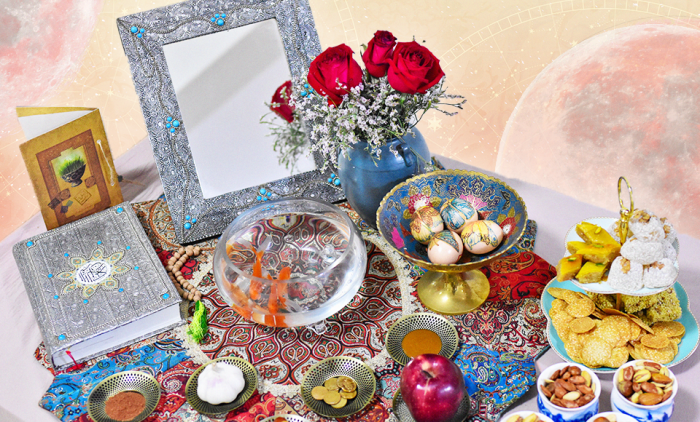
Food plays a crucial role in Persian New Year traditions, going far beyond simply providing nourishment. It serves as a powerful tool for creating a festive atmosphere, expressing cultural identity, and strengthening family bonds. Through symbolic dishes and culinary rituals, Nowruz celebrations embrace hope, renewal, and the promise of a new beginning.
The Significance of Symbolic Dishes
The selection of specific dishes for Nowruz is not arbitrary; each one carries symbolic meaning, reflecting the hopes and aspirations of the Persian people. For instance, the vibrant green color of sabzi (fresh herbs) represents growth, renewal, and the arrival of spring.
The sweetness of sweets like baklava and reshte (vermicelli noodles) symbolize good fortune and prosperity.
The Culinary Legacy of Persian New Year Recipes
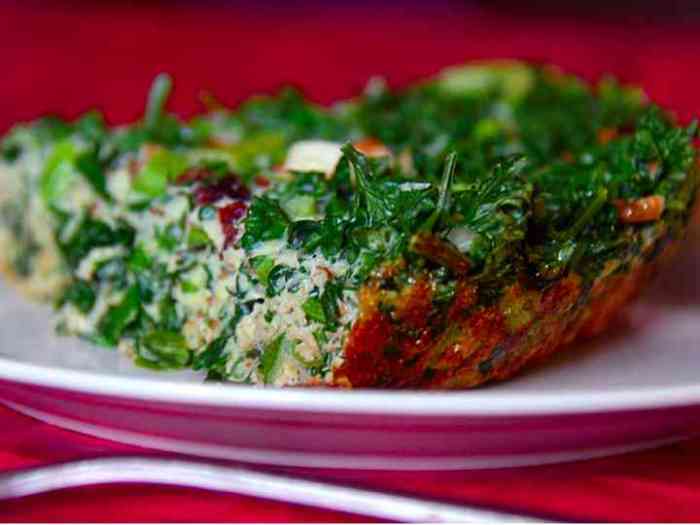
The vibrant flavors and aromatic spices of Persian New Year recipes are not just a testament to culinary expertise, but a living legacy passed down through generations. These dishes are more than just food; they are a tapestry woven with stories of family, tradition, and cultural identity.
The Enduring Power of Tradition
The recipes have been passed down through generations, often shared through oral tradition and family gatherings. Each dish carries with it the whispers of ancestors, their wisdom, and their love for their heritage. This transmission of knowledge, often passed from mothers to daughters, grandmothers to granddaughters, has ensured the survival of these recipes through time.
The act of preparing these dishes is a ritual that connects individuals to their past, fostering a sense of belonging and continuity.
Recipes as Cultural Bridges
These recipes are not confined to geographical boundaries; they have traveled across continents, carried by the diaspora. In the homes of Persian families around the world, these dishes continue to be prepared, celebrated, and enjoyed. They serve as cultural bridges, connecting individuals to their roots and preserving their heritage.
The preparation of these dishes in foreign lands becomes a way to maintain a connection to their homeland and to share their culture with others.
The Importance of Preservation
The preservation of traditional culinary practices is paramount. As globalization and modernization continue to influence food choices, the importance of safeguarding these recipes becomes increasingly critical. Documenting these recipes, sharing them through cookbooks, online platforms, and culinary workshops ensures their survival for future generations.
The transmission of these culinary traditions, along with their stories and significance, is essential for maintaining cultural identity and heritage.

